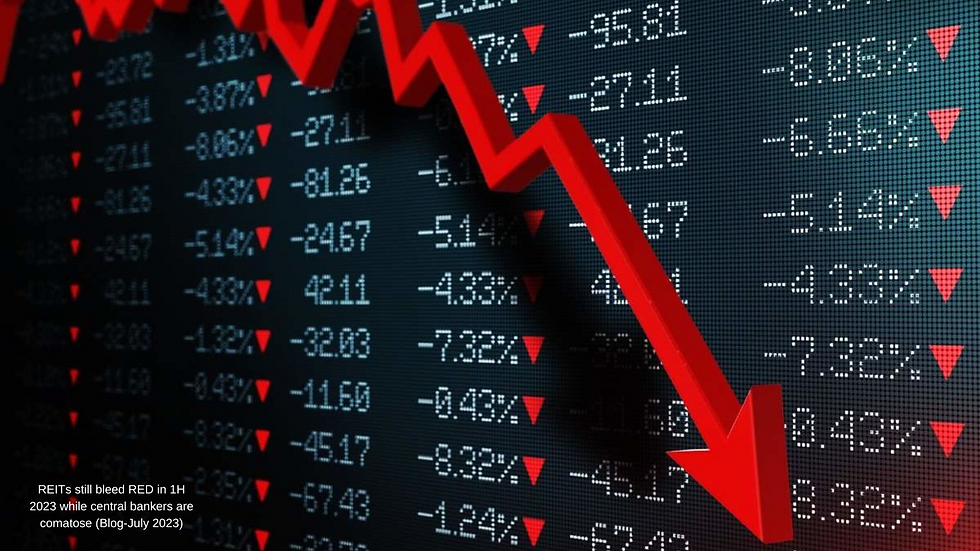WILL GLOBAL MARKETS FINALLY CRAWL OUT OF THEIR ZOMBIE STATUS IN 2013 ?
- by Gabriel Yap

- Nov 18, 2017
- 4 min read
01/2013-
After four years since the depth of the global financial crisis, global markets are indeed showing incipient signs of crawling out from their zombie zig-zag trading ranges to post higher highs in 2013.

Apparently, the Fed and the ECB have saved the day through their unconventional flowing-the-markets with excessive liquidity strategies. However, have such strategies been efficient and effective? Can we count on these strategies to take global markets higher in 2013?
Many investors would agree that massive liquidity injections were initially effective in unfreezing nervous credit markets and arrested the worst of the global financial crisis. However, does the panacea lies in resorting to the same strategies year after year? What would happen to global markets when the plug on liquidity flow is finally put in place, in say 5 years time?
One reason why markets went nowhere in 2012 was the European crisis and nations like the US and China were mired in a classic “liquidity trap” – the global financial crisis created havoc to both public sector and private sector balance sheets. Thus, when the liquidity tap was turned on re the rescue package, most of the funds were channeled to pay down hugh debts rather than using these new liquidity to lend and boost consumer demand.
The plight of the American consumer is a classic case in point – consumer spending drove two-thirds of US GDP growth before the financial crisis. This was mainly driven by property and credit boom precedent to the crisis. When the bubble burst, the US consumer had no choice, to be pay down debt to rescue their homes, rebuild their personal savings, all to the detriment of cutting down on consumer spending. Understandably, the dramatic cut in consumer spending drove US GDP close to negative for a few quarters.
In the rescue process, the Feb has had to quadruple their balance sheets to close to US$4 trillion while the ECB has doubled its balance sheet to slightly more than US $3.5 trillion and thereby creating a new problem for global markets in the next 5 years – how to downsize of these massive debts without causing havoc to global markets?
Essentially, what the Fed and ECB has done – buying sovereign debts issued by fiscal authorities would effectively have offset free market setting of interest costs, subsidizing public sector profligacy. The longer they stay with this strategy, the longer global growth will be stymied as this is another dampener to a normal cyclical recovery.
For me, as a global investor, I will add “follow-the-money” strategy in addition to traditional fundamental or technical analysis if you want to make the next “kill” in the money investment game.
Frankly, will global markets finally crawl out of the zombie status and central banks able to control the hugh US$8 trillion of excess liquidity built-up to contain the global financial crisis in 2013? I don’t know, but I do know like the gangnam style, where excess liquidity flows, “follow-the-money” strategy is a key dance style in 2013.
In this respect, Asian economies like Phillipines and Indonesia have benefited from this excess liquidity flow. Coupled with their respective growing middle-class, both markets are poised to move higher in 2013.
However, no society can sustain strong economic growth indefinitely, and I think both Phillipines and Indonesia economies will level off sometime in the next 2 - 3 years and approximate their respective “normal” levels of growth driven by sustained consumer demand. Their respective financial markets should reflect this trend. As a matter of fact, most fund managers have allocated a lot of investments in the Philippines and valuations are at all-time extreme rich in the past decade. In terms of valuations, markets in Southeast Asia, with the exception of Singapore, are within 5% shy of their peaks reached during the rebound from the 2007 global financial crisis.

As a global investor, one must know how to party, but also to be aware that one would not be drunk when the lights turn out when the party ends. One must always look at where is growth becoming more positive? Where is growth changing in direction and magnitude? I think it would reside in China, South Korea, India, Hong Kong and Singapore for 2013.
In China, Russia and possibly parts of India, economic development will leave a legacy of wealthier but more complex economies, with substantial cross border demands, prosperous bourgeoisies and a well-off middle class. There would be greater demand for upscale shopping malls, consumer goods and energy needs. Finding investments in these areas would be beneficial for the global investor.
Take for instance China – GDP should rebound to 8.2% in 2013 bolster from recoveries in exports, domestic consumption and local infrastructure investments like re-investments in the railway sector. Thus, earnings growth of Chinese companies are likely to spring positive surprises.
To me, as a global investor, I will always be wary of “new paradigm of growth” or “the mirage of immortality” in markets or companies that I invest in. In “follow-the-money flow” strategy, I continue to watch the companies cash flows and balance sheet with a hawk’s eye, while waiting for the eagle to soar.
Happy Investing 2013!




Comments